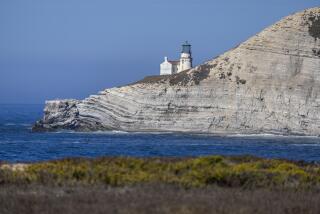A Man Enraptured by the Raptors : Morley Nelson, 70, Is Driving Force Behind Bird of Prey Preserve
- Share via
SNAKE RIVER BIRDS OF PREY AREA, Ida. — Morley Nelson, 70, watched in awe as a bald eagle soared through puffy white clouds, then landed on a narrow ledge halfway up the 700-foot sheer cliff.
“I envy you, big eagle,” Nelson said, confessing to a recurrent dream of catching the wind and soaring with falcons and eagles in the spectacular vertical Garden of Eden for raptors 30 miles south of Boise.
Nelson, the grand old man of American falconry, was the driving force behind the establishment of the Snake River Birds of Prey Area in 1980, 482,640 acres administered by the U.S. Bureau of Land Management. He spent 30 years trying to get the steep canyon set aside for the protection and study of eagles, falcons, hawks, osprey, vultures and owls.
“My heart sings every time I come here to these cliffs to marvel at nature’s greatest fliers, these noble, totally inspirational birds, among the most beautiful, graceful and fierce of all living creatures,” Nelson said.
Every year hundreds of visitors float down the Snake River in boats through the heart of the Birds of Prey Area armed with binoculars and spotting scopes. Mid-March through June is the best time to see these birds dive for their prey at speeds greater than 150 m.p.h.
Birds of prey, also called raptors, have exceptionally keen eyesight. Soaring eagles are able to spot a rabbit two miles away. More than 700 pairs of raptors, representing 14 different species, come here to nest and raise their young.
“If it wasn’t for Morley Nelson, the World Center for Birds of Prey would not be located in Boise,” said Bill Burnham, 39, president of the Peregrine Fund Inc.
The nonprofit Peregrine Fund, established in 1970 by wildlife biologist Tom Cade at Cornell University in Ithaca, N.Y., moved into its new $1-million research facility on a 280-acre site near the Boise airport three years ago.
It is the largest scientific complex in the world devoted to the research and breeding of raptors. Cade founded the Peregrine Fund to prevent the extinction of the peregrine falcon and restore it to its natural range in America. By the 1960s, the bird had vanished in the states east of the Mississippi and very few survived in the West.
By breeding peregrine falcons in captivity and by releasing more than 2,000 young in the wild, the Peregrine Fund has almost single-handedly replenished the supply of peregrine falcons in this country. Today the organization is concerned with the preservation, protection and well-being of all birds of prey in America and throughout the world.
Nelson is vice chairman of the Peregrine Fund and active in the operation of the World Center for Birds of Prey, which is affiliated with Boise State University. BSU this semester inaugurated the nation’s only master’s degree program in raptor biology and ecology. Nelson is one of the instructors.
Because raptors are synonymous with Idaho, the state held a Birds of Prey Festival last May in Boise. A highlight of the celebration was a tribute to Morley Nelson.
The second annual Birds of Prey Festival will be held May 14-16 in Boise. Featured will be bird shows, exhibits of paintings and drawings of raptors, lectures and films about the birds and a Birds of Prey Run.
On the steep hillside behind Morley and Pat Nelson’s Boise home are a series of mews--large enclosures for eagles, falcons and hawks. As Morley Nelson walked up the hill, grasping with his gloved hand the rarest of falcons--a white gyrfalcon from Greenland--a bald eagle squawked and bellowed.
“That’s Pearl. You’ve seen her on television,” Nelson said. “She’s the eagle in the Postal Service commercials.
“These characters talk to me. Pearl is telling me: ‘Hello. Come on over here old fellow. I want something to eat.’ ” Nelson’s birds of prey come to him after being shot, caught in traps or injured from running into wires and structures. He nurses the birds back to health and studies them for research projects. He often releases them when they are well.
Nelson trained the birds of prey that appeared in TV’s “Wild Kingdom” series, in several feature films and numerous documentaries, and he has traveled the world as a consultant for individuals and organizations working with raptors. He also designs safe nesting platforms for power poles to prevent eagle electrocutions.
More to Read
Sign up for Essential California
The most important California stories and recommendations in your inbox every morning.
You may occasionally receive promotional content from the Los Angeles Times.










